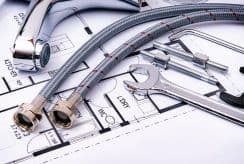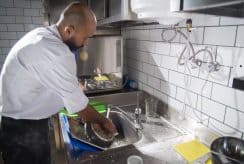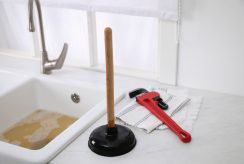Plumbing is a highly important part of any home. However, it is not without its risks. From tetanus and other infections to toxic chemicals, there are many dangers that plumbers face on a daily basis.
Plumbing work often involves the use of chemicals such as solvents and drain cleaners. These can be dangerous to your skin and eyes, so it is important to wear proper safety equipment.
Sewage
When a home’s drains and toilets become clogged with debris and fail to properly transport wastewater away from the home, sewage backup occurs. The resulting mess is not only unpleasant but poses health hazards for the residents. Sewage contains bacteria, viruses, fungi, and other contaminants that can make people sick. Sewage can also cause serious damage to property, destroying floors, walls, furniture, and appliances. It’s essential to hire a plumber to handle this emergency as soon as possible to minimize the amount of damage and protect your family’s health.
Fortunately, there are many ways to prevent sewage backups. For example, you can keep your drains clear of hair, fat, and grease by regularly removing these items from your sinks and toilets. It’s also a good idea to invest in a quality sump pump for your basement or home crawlspace. A professional plumber can also help you determine whether your home’s sewage line is backed up due to blockage or flooding.
Another risk associated with sewage is the possibility of disease-causing microorganisms like legionella, which can grow in conditions that are favorable for biofilm formation inside plumbing pipes. This can lead to potentially fatal illnesses, such as legionnaires’ disease or Pontiac fever, in those who come into contact with the contaminated water. This is another reason why it’s important to wear face masks, rubber gloves, and protective boots when working in areas prone to sewage overflow.
To avoid injury while performing plumbing tasks, ensure that all equipment is in good condition and properly tagged. Also, it’s essential to follow proper work safety procedures when using chemicals. This includes reading and following product labels, wearing appropriate safety gear, and always working with a partner. In addition, you should keep a first aid kit on hand for any injuries that might occur while working. This will ensure that you can immediately address any medical emergencies. Lastly, always take breaks to rest and refresh your body. This will help prevent fatigue, which can lead to an accident. Ultimately, while eliminating the risks entirely may be impossible, implementing best practices can significantly lower your risk of injury.
Chemicals
Plumbing often involves working with a variety of chemicals and solvents including drain cleaners, glues, and soldering materials. These can pose serious health risks to plumbers if they come into contact with them or are inhaled. Proper use of PPE (personal protective equipment) such as gloves, safety glasses, and a face mask can minimize these hazards.
Chemical drain cleaners contain corrosive chemicals such as sodium hydroxide (lye) and sulfuric acid which are effective at breaking down clogs, but are also toxic to pipes. They can eat away at the material of both newer PVC systems and older metal pipes, weakening them over time and leading to leaks and corrosion. They can also contaminate the environment by seeping into groundwater and rivers.
Inhaling fumes from chemical drain cleaners can be hazardous to the lungs as well, especially for young children and people with compromised respiratory conditions like asthma. They can also cause skin irritation and dermatitis. Lastly, improper disposal of these chemicals can contaminate the water supply and cause illness in those who consume it.
Working near raw sewage or septic tanks can also expose plumbers to pathogens such as viruses, fungi, and bacteria that can cause hepatitis, E.coli diarrhea, gastroenteritis, and other illnesses. Proper PPE, as well as frequent handwashing with sanitizer and disinfectant wipes, can help to minimize the risk of exposure to these contaminants.
It is essential for plumbers to read and follow the product instructions and warnings on all chemicals they work with. It is also important to review the Material Safety Data Sheets for each chemical, which provide detailed information about its composition, potential hazards, recommended precautions and handling procedures, first aid treatment instructions, and more. This will help to ensure that plumbers take full precautions when working with these hazardous materials.
Hazardous Materials

In many cases, plumbers encounter hazardous materials when working on plumbing projects. These include asbestos and lead, which can pose health risks if exposed. These hazards can be found in old pipes and building materials that were used for insulation and piping in older buildings. Asbestos exposure can cause lung cancer and mesothelioma, so it’s important for plumbers to take proper precautions when they work with asbestos-containing materials.
Plumbers also often handle hazardous chemicals, such as drain cleaners and solvents. These can pose a risk to plumbers’ health if not handled correctly. This includes reading the appropriate labels and instructions on chemicals, as well as wearing proper PPE when handling them. It is also important to keep a clean workspace, and to dispose of hazardous waste safely.
Another common hazard for plumbers is confined spaces, such as crawlspaces or basements. These can be difficult to work in and are at risk of flooding, fires, and fume inhalation. It is important for plumbers to follow confined space procedures, such as using gas detectors and following proper entry and exit techniques.
In addition to confined spaces, plumbers may also be exposed to electrical hazards when working on plumbing tasks. This can include working in close proximity to electrical wiring and equipment, which can pose a risk of electrocution or electrical shock. It is important for plumbers to turn off all power sources before beginning work, and to wear rubber-soled shoes and gloves when working with electrical equipment.
While avoiding these hazards is challenging, it is not impossible. By following proper safety procedures and using a high-quality plumbing pipe material, such as FlowGuard CPVC, you can ensure that your domestic water system is safe, reliable, and provides you with the healthy and clean water you need to live your life. To find out more about how FlowGuard CPVC mitigates the hidden dangers of other plumbing pipes, download our free Homeowners Guide to CPVC today. It will provide you with step-by-step guidance on what effective CPVC plumbing looks like, as well as a wealth of industry leading water safety advice.
Noise
The smooth flow of water through your pipes is a key element to your home’s plumbing system, ensured often by Lubbock plumbers. It allows you to enjoy hot and cold water in all parts of the house whenever needed. However, when your piping starts making noises like loud banging or squealing, it could be a sign of some serious plumbing issues. These pipes may be loose or damaged and they could eventually cause significant damage to your property.
Some noises from your plumbing are harmless and can be attributed to natural causes, such as the light whooshing sound produced when water moves through pipes. Other sounds, such as rattling or clanging, are caused by pipes that have become loose over time. This can be due to age and wear, or because they were never fitted properly to begin with. This issue is known as water hammer and can be easily remedied by installing a set of water hammer arrestors.
Other types of plumbing noises, such as squealing and whistling, can be caused by the movement of minerals within your piping. These minerals are typically a mixture of calcium and magnesium which can cause the pipes to make these sounds when they circulate through your plumbing system. They can also be the result of worn down washers and nuts or a blocked pipe. If you hear squealing or whistling noises coming from your pipes, it is important to call in a plumber right away.
If your pipes are making these disturbing noises, it’s crucial to find out their source and take immediate action to avoid further damage. The following tips, backed by professional plumbers, can help you identify the cause of these noises and silence them for good. They include conducting a thorough inspection of your piping, using proper padding to reduce vibrations, and ensuring that the pipes are securely fastened in place. By implementing these simple DIY solutions, you can ensure that your home is a peaceful haven and not a symphony of unwelcome pipes.





